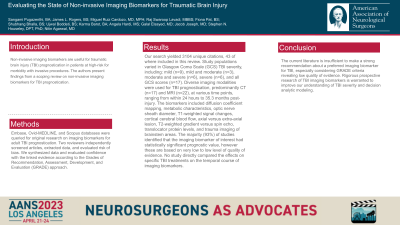Evaluating the State of Non-invasive Imaging Biomarkers for Traumatic Brain Injury
Friday, April 21, 2023


Sangami Pugazenthi, BA
Medical Student
Washington University School of Medicine in St. Louis
St. Louis, Missouri, United States
ePoster Presenter(s)
Introduction: Non-invasive imaging biomarkers are useful for traumatic brain injury (TBI) prognostication in patients at high-risk for morbidity with invasive procedures. The authors present findings from a scoping review on non-invasive imaging biomarkers for TBI prognostication.
Methods: Embase, Ovid, MEDLINE, and Scopus databases were queried for original research on imaging biomarkers for adult TBI prognostication. Two reviewers independently screened articles, extracted data, and evaluated risk of bias. Data was synthesized and confidence was evaluated with the linked evidence according to the Grades of Recommendation, Assessment, Development, and Evaluation (GRADE) approach.
Results: The search yielded 3104 unique citations, 43 of which were included in this review. Study populations varied in Glasgow Coma Scale (GCS) scores including: mild (n=9), mild and moderate (n=3), moderate and severe (n=6), severe (n=6), and all GCS scores (n=17). Diverse imaging modalities were used for TBI prognostication, predominantly CT (n=17) and MRI (n=22), at various time points, ranging from within 24 hours to 35.3 months post-injury. The biomarkers included diffusion coefficient mapping, metabolic characteristics, optic nerve sheath diameter, T1-weighted signal changes, cortical cerebral blood flow, axial versus extra-axial lesion, T2-weighted gradient versus spin echo, translocator protein levels, and trauma imaging of brainstem areas. The majority (93%) of studies identified that the imaging biomarker of interest had statistically significant prognostic value, however these are based on very low to low levels of quality of evidence. No study directly compared the effects of specific TBI treatments on the temporal course of imaging biomarkers.
Conclusion : The current literature suggests that based GRADE criteria, data on imaging biomarkers for TBI is of low quality. Rigorous prospective research of TBI imaging biomarkers is warranted to improve our understanding of TBI severity and decision analytic modeling.
Methods: Embase, Ovid, MEDLINE, and Scopus databases were queried for original research on imaging biomarkers for adult TBI prognostication. Two reviewers independently screened articles, extracted data, and evaluated risk of bias. Data was synthesized and confidence was evaluated with the linked evidence according to the Grades of Recommendation, Assessment, Development, and Evaluation (GRADE) approach.
Results: The search yielded 3104 unique citations, 43 of which were included in this review. Study populations varied in Glasgow Coma Scale (GCS) scores including: mild (n=9), mild and moderate (n=3), moderate and severe (n=6), severe (n=6), and all GCS scores (n=17). Diverse imaging modalities were used for TBI prognostication, predominantly CT (n=17) and MRI (n=22), at various time points, ranging from within 24 hours to 35.3 months post-injury. The biomarkers included diffusion coefficient mapping, metabolic characteristics, optic nerve sheath diameter, T1-weighted signal changes, cortical cerebral blood flow, axial versus extra-axial lesion, T2-weighted gradient versus spin echo, translocator protein levels, and trauma imaging of brainstem areas. The majority (93%) of studies identified that the imaging biomarker of interest had statistically significant prognostic value, however these are based on very low to low levels of quality of evidence. No study directly compared the effects of specific TBI treatments on the temporal course of imaging biomarkers.
Conclusion : The current literature suggests that based GRADE criteria, data on imaging biomarkers for TBI is of low quality. Rigorous prospective research of TBI imaging biomarkers is warranted to improve our understanding of TBI severity and decision analytic modeling.
